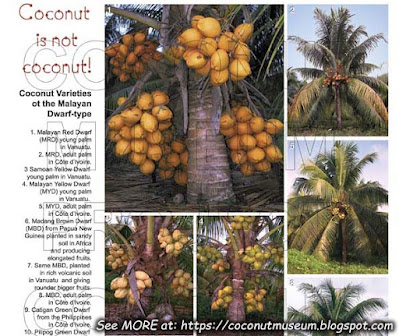We released recently a poster describing the amazing coconut varieties of French Polynesia.
Legend is as follow (in French, to be translated):
1. Six variétés de cocotier Ha’ari Papua dont deux rouges, trois jaunes et une verte. A Kauehi, il en existe aussi une de couleur abricot qui produit de gros fruits, voir photographie (a).
2. Trois Nains Compacts Rouges (Maria Moorea, Alfred Teriitehau, Karsher); deux Abricots (Rangiroa et Requin); trois Verts (à Gros fruits, à fruits rentrants, à petits fruits). Il existe aussi des Nains Compact bruns (g) et Jaunes (e).
- 3. Cinq Nains à troncs fins: Jaune Malais Population Tahiti; Rouge Malais; Vert Fakahina (fruits ronds); Vert Kauehi (fruits pointus); Vert Brésil à fruits ovales, voir aussi (i).
- 4. Huit variétés de Grands de gauche à droite: Riata; Pia à l’amande gélatineuse; à feuilles retombantes et fruit en poire; Tahiti; Rangiroa; à forme de Rennell; Bol ; gros fruits à bourre épaisse de Rangiroa.
- 5. Quatre cocotiers Kaipoa, dont la bourre des jeunes fruits est tendre et/ou sucrée; noix de Grands d’Aratica, Ta’aha et Fangatau; (b) Nain Vert Compact Kaipoa de Katiu.
- 6. Deux Grands Nape, dont l’un produit régulièrement des fruits vides dits « bananes».
- 7. Trois sortes de coco à corne, originaires de Ta’aha, Bora Bora et Tatakoto.
- 8. Hybride de Raiatea, croisement du Nain Vert Brésil et du Grand de Rangiroa.
For illustrating this section of the Ecomuseum, we can produce on request at least five large size HD poster (up to 180x100 cm in size). Some of these posters should be adapted to each country, on a case-by-case basis, in order to prominently feature locally produced coconut products. It is also possible to buy or rent items from the personal collection of Dr R. Bourdeix.
A first poster can be produced to illustrate the genetic diversity of the coconut palm as a whole. Three posters can more specifically describe the diversity of Tall, Thin-stemmed Dwarf and Compact Dwarf coconut palms. Another poster could present elements of the botanical history of the coconut palm and try to explain the dissemination of this palm on the different continents. Another could describe rare coconut varieties such as spicata (see the example below).
 |
| Poster on Tall-types varieties Click on the picture to see the full poster. |
Traditional coconut varieties are generally
classified in four main types:
- Tall-types, which represents 90 to 95 % of all existing coconut palms. They are often called simply “Talls”. They generally form quite heterogeneous cross-pollinating populations. Talls can grow at a rate of more than 50 cm annually when young and flower at 6-10 years with an economic life span of 60-70 years.
- Preferentially Self-pollinating Dwarf-types. They are often called Dwarfs, Fragile Dwarfs or Malayan-Type Dwarfs, because the Malayan Red and Yellow Dwarfs are the most widely known cultivars of this group. They grow at a rate of 15 to 30 cm annually, have a productive life span of 30-40 years and usually start flowering 12 to 30 months after field planting. Apart from their usually short height, these varieties show a combination of common characteristics: autogamic preference, small size of organs, precocity, and rapid emission of inflorescences. Because of the last two characteristics, they play an important role in genetic improvement programs.
- Preferentially Cross-pollinating Compact Dwarf-types are generally called simply Compact Dwarfs or Niu Leka-type Dwarfs (because the Niu Leka Dwarf from Fiji is the most widely known cultivar of this type). This type of dwarf coconut, with short thick stem and wide leaflets, is much rarer and mainly found in the Pacific region.
- A few intermediate forms called Semi-Tall types, intermediate between Dwarfs and Talls, with variable reproduction modes. The most famous is the King Coconut cultivar from Sri Lanka, self-pollinating and producing bright orange pointed fruits.
 |
| Poster on Malayan-type Dwarf varieties Click on the picture to see the full poster. |
Until recently Dwarf coconut palms were
mostly used in the gardens of houses, planted for their decorative value and
the sweetness of their young, tender drinking nuts. They differ from Tall-type
coconut palms through earlier flowering, slower vertical growth, a tendency
towards self-pollination, and higher susceptibility to drought and insect
attacks. The first fruits produced by Dwarf coconut palms often hang to the
ground
Brazil and other countries like India, the Philippines, Thailand, and Vietnam recently developed very large and profitable plantations of Dwarfs for coconut water production. Two varieties are mainly used, the Brazilian Green Dwarf (very sweet water) and the Aromatic Green Dwarf (special perfumed flavour of the water).
 |
| Poster on Compact Dwarf varieties Click on the picture to see the full poster. |
 |
| Poster on Spicata forms Click on the picture to see the full poster. |
02. Nain Compact Rouge Alfred T
03. Nain Compact Rouge Hôpital Moorea
04. Nain Compact Rouge Afareiatu
Les cocotiers Nains à troncs fins
17. Nain Rouge Malaisie
18. Nain Jaune Malaisie population Tahiti
34. Hybride Nain Vert Brésil x Grand de Rangiroa
Variétés et formes encore non décrites au catalogue

